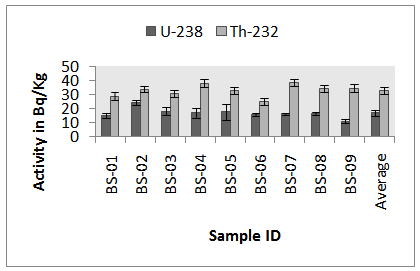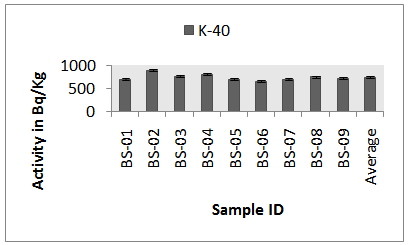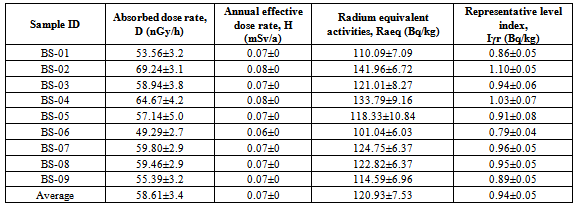Q. M. R. Nizam1, M. A. Ginnah1, M. M. Rahman1, M. Kamal2, M. I. Chowdhury2
1Department of Physics, University of Chittagong, Chittagong-4331, Bangladesh
2Radioactivity Testing and Monitoring Laboratory, BAEC, CMCH Campus, Chittagong
Correspondence to: Q. M. R. Nizam, Department of Physics, University of Chittagong, Chittagong-4331, Bangladesh.
| Email: |  |
Copyright © 2012 Scientific & Academic Publishing. All Rights Reserved.
Abstract
In order to assess the activity concentration of natural and anthropogenic radionuclides in the Charfassion Island, Bhola, Bangladesh, the upper level sediment samples were analyzed by using Broad Energy Germanium (BEGe) detector. Average activity concentrations of 238U, 232Th and 40K were found 16.82±2.18 BqKg-1, 32.84±2.56 BqKg-1 and 743.52±22.07 BqKg-1. These results were used to calculate the radiation hazard parameters like radium equivalent activities (Raeq), representative level index (Iγr). Representative level index is used to estimate the level of gamma radiation hazard associated with the natural radionuclides. Due to natural radionuclides in sediment, the effective annual outdoor dose in the study area is 0.07 mSv; which is within the accepted range 0.07 mSv and representative level index (Iγr) is also found to be 0.94 Bq/Kg. The findings from this research work would be useful to evaluate the population exposure from radionuclides in this island.
Keywords:
Natural Radioactivity, Gamma Spectrometry, Bege Detector, Absorbed Dose Rate, Effective Annual Dose
Cite this paper: Q. M. R. Nizam, M. A. Ginnah, M. M. Rahman, M. Kamal, M. I. Chowdhury, Assessment of Activity Concentrations of Radionuclides from Upper Level Sediment in Charfassion Island, Bhola, Bangladesh, Journal of Nuclear and Particle Physics, Vol. 3 No. 3, 2013, pp. 36-39. doi: 10.5923/j.jnpp.20130303.02.
1. Introduction
Environmental radioactivity measurements are necessary for determining the background radiation level due to natural radioactivity sources of terrestrial and cosmic origin. The terrestrial component is due to the radioactive nuclides that are present in air, sediments, rocks, water and building materials in amount that vary significantly depending on the geological and geographical features of a region and appear at different levels in the soils of each region in the world[1, 2, 3]. The cosmic radiation originates from spaces as cosmic rays whose contribution to background changes mainly with elevation and latitude. In addition to the natural sources, the level of background radiation region is affected from man-made sources such as those from nuclear sources and accidents[4]. Besides the radiological threat is increasing day by day due to increasing the nuclear activities. Such types of activities are frequently occurred in our neighbouring country. The aim of the present study is the assessment of the radioactivity contamination level in the cyclones “Sidr” and “Aila” affected areas. Most of the affected areas with above mentioned cyclones are situated in southern side of Bangladesh. This is why the present study was carried out in Bhola island. For this, nine different points were selected which are under area 2207’35.63” N to 90048’26.41” E. From the selected area coastal riverbed sediment were collected with soil iron corer having diameter 6 cm. Many areas of this country were surveyed for radiological risk assessments except this island. So, for the assessment of radiation hazard in Bangladesh, it is essential to determine the concentration of terrestrial radionuclides in this island. This research work will find out the distribution of different radionuclides in upper (surface) level sediments of this area and thereby assessed the radiation hazard. So, this work will be valuable in the development of rules and regulation for the health and environmental safety.
2. Materials and Methods
All collected solid and powdered samples were air dried under laboratory temperature. Then the samples were cleaned and dried at 1200 C in an electric oven for 24 hours to remove moisture. After drying in oven the samples were crushed to fine powder with mortal and pastel. These samples were transferred to cylindrical plastic containers which are with height 3.5 cm and dia. 6.5 cm. these containers were marked individually with identification number, name and location of the sample, date of preparation and net weight. Then containers were sealed tightly with cap and wrapped with Teflon and thick vinyl tapes inside and outside with their screw necks and finally air tightened with polythene pack and stored for four weeks to allow secular equilibrium between the long lived U-238, Th-232 with their short lived progeny respectively. The sampling site Charfasion island, Bhola is shown in Fig-1 below: | Figure 1. Sampling site Charfassion island, Bhola, Bangladesh |
Since most of the radio-nuclides are gamma emitter, gamma spectroscopy can reveal dominant sources of radioactivity. A broad energy germanium (BEGe) detector BE3820 made by Canberra Industries Inc, USA was used to record the gamma emission from the soil samples. This detector can efficiently measure gamma in the energy region from 3 keV to 3 MeV (Canberra, USA). The measured resolution of the detector was 1.9 keV (FWHM) at gamma energy 1332 keV. Efficiency and calibration of the detection system were done against the standard sources provided by International Atomic Energy Agency (IAEA). The efficiency of a particular detector varied with the distance between the source and detector and its geometry. By placing the standard source at the top of window of the detector, the peaks were accumulated for 20,000 seconds, and the peak area for each radionuclide was calculated by using the specialized computer program Windows based Genie-2000 software for quantitative analysis of nuclear spectroscopy available in Radioactivity Testing and Monitoring Laboratory (RTML), Chittagong. Each of the collected and prepared samples was placed on the top of the BEGe detector within the shielding arrangement and counted for 20,000 seconds, after adjustment of the necessary parameters such as resolution, peak to Compton ratio etc, and measurement of minimum detectable activity of the detectors. Activity of 238U radionuclide was determined from the observed counts at gamma energies 241.98 keV, 295.21 keV and 351.92 keV emitted by the daughter nuclide ²¹⁴Pb and also at energies 609.31 keV, 1120.29 keV and 1764.49 keV emitted by the another daughter ²¹⁴Bi. For the radionuclide ²³²Th, counts at energies 238.63 keV of ²¹²Pb, 338.40 keV, 911.07 keV and 969.11 keV of ²²⁸Ac and 583.19 of ²⁰⁸Tl were used. Gamma peaks at energies 1460.75 keV and 661.66 keV, respectively, were used for the determination of activities of ⁴⁰K and ¹³⁷Cs. The net events were obtained after subtracting the background. These net activities were calculated by using the formula: | (1) |
Where, e is the counting efficiency (in fraction) of the detector at the measured gamma energy, i is the intensity of the measured gamma from the radio-nuclide and m is the mass of soil sample in kg.The outdoor dose rates and annual effective dose rate were calculated by using the following formula[5] | (2) |
And H = (D outdoor *0.7*0.2*24*365*10-6) Where, AU, ATh, and AK are the average activity concentrations of 238U, 232Th and 40K, respectively in sediment in units of Bq/kg.Radiological hazard index the radium equivalent activity concentration (Raeq) and representative level index (Iγr) was calculated according to[6]: | (3) |
 | (4) |
Where, AU, ATh, and AK are the average activity concentrations of 238U, 232Th and 40K, respectively in sediment in units of Bq/kg.
3. Results and Discussion
3.1. Activity Concentrations
Table 1. The measured activity concentrations of natural and anthropogenic radionuclides 238U, ²³²Th ,⁴⁰K and 137Cs in the sediment samples
 |
| |
|
The measured activity concentrations of natural and anthropogenic radionuclides 238U, ²³²Th and ⁴⁰K in the sediment samples are given in Table-1. The study shows the range of activity of 238U was found in 24.35±5.56 BqKg-1 to 10.86±0.85 BqKg-1 with an average value of 16.82±2.18 BqKg-1. The activity of 232Th was found in the range of 38.31±2.73 BqKg-1 to 24.86±2.21 BqKg-1 with an average value of 32.84±2.56 BqKg-1. The highest activity of 40K was found 900.20±22.51 Bq.kg-1 and the lowest was 650.0±21.20 Bq.kg-1 with an average activity of 743.52±22.07 Bq.kg-1. Fig-2 represents comparison between the activity concentration of 238U and 232Th in different sediment samples whereas Fig-3 represents the same for 40K. Figure-6 represents these measured values of natural radionuclide concentrations with world average values. | Figure 2. Comparison between concentrations of U-238 and Th-232 in different sediment samples |
 | Figure 3. Activity concentration of K-40 in different sediment samples |
 | Figure 4. Comparison of measured activity concentration with world average |
3.2. Radiational Hazard Parameters
i. The outdoor gamma ray exposure rate in air at one meter height above the ground due to natural radionuclides in sediment was found with an average of 58.61±3.47 nGyh-1 which is lower than the world value 59 nGyh-1[4].ii. To estimate the annual effective dose rates, the conversion coefficient from absorbed dose rate in air to effective dose (0.7) and outdoor occupancy factor (0.2) proposed by UNSCEAR (2008) were used. The resulting average of annual effective dose is 0.07 mSv/a while the world average annual effective dose is 0.07 mSv/a[4].iii. For the estimation of radiation hazards due to natural radio-nuclides it is now common practice to calculate the radium equivalent activity (Raeq) and representative level index (Iγr). The resulting average of radium equivalent activity (Raeq) is 120.79±7.62 BqKg-1 and the resulting average of representative level index (Iγr) is 0.94±0.05 BqKg-1.The above values are shown in the table-2 given below. And comparisons of these values with world average are shown in table-3.Table 2. The average values of outdoor dose rate, annual effective dose, radium equivalent activities and representative level index
 |
| |
|
Table 3. Comparison of results of the present study with corresponding world average values worldwide value and regional study
 |
| |
|
4. Conclusions
In the present study the activity concentrations of 238U, 232Th are lower than the value of the world averages (33 Bq.kg-1for 238U, 45 Bq.kg-1for 232Th)[8] but the activity concentration of 40K is greater than the world average value (420 Bq.kg-1for 40K)[8]. The increasing trend of 40K is due to the presence of loamy and clay sediments[9] and may be due to the high content of monazite[10]. The value of outdoor dose rate is lower than the world average value whereas radium equivalent activities and representative level index are greater than the world average value. But the average value of annual effective dose is same as world average value. And there were no detection of anthropogenic radionuclides 137Cs. This study may provide scientific information on contamination of this important region. In spite of the randomness in the choice of the samples and the choice of locations from where the samples were collected for the study of the natural environment radiation, it is interesting indeed to observe that all samples exhibit the presence of 40K radionuclides and daughter product of 238U and 232Th radionuclides. The results may be used as a reference data for monitoring possible radioactivity pollutions in future.
ACKNOWLEDGEMENTS
Authors are grateful to Dr. M. I. Chowdhury, ex-director of the Radioactivity Testing and Monitoring Laboratory, Chittagong for his valuable suggestions in this study.
References
| [1] | Iqbal, M., Tufail, M. and Mirza, S.M., “Measurement of Natural Radioactivity in Marble Found in Pakistan Using a NaI(Tl) Gamma-Ray Spectrometer”. Technical Note, Journal of Environmental Radioactivity, 51(2), 2000, 255–265. |
| [2] | Anagnostakis, M.J., Hinis, E.P., Simopoulos, S.E. and Angelopoulos, M.G. “Natural Radioactivity Mapping of Greek Surface Soils”. Environmental International, 22 (1), 1996, 3–8. |
| [3] | Shender, M.A., “Measurement of Natural Radioactivity Levels in Soil in Tripoli”. Applied Radiation and Isotopes, 48 (1), 1997, 147–148. |
| [4] | UNSCEAR-2000: “Sources and biological effects of ionizing radiation”, Annex B: Exposures from Natural Radiation Sources”, United Nations Scientific Committee on the Effects of Atomic Radiation, New York, 2010. |
| [5] | UNSCEAR-1988: “Sources, effects and risks of ionizing radiation”, United Nation Scientific Committee on the Effects of Atomic Radiation, Report on the General assembly with annexe, New York, 1988. |
| [6] | J. Beretka and P. J.Mathew: “Natural radioactivity of Australian building materials, industrial wastages and byproducts”. Health Physics, 1985, 48:87-95. |
| [7] | Chowdhury, M. I., Alam, M. N. and Hazari, S. K. S. “Distribution of radionuclides in the river sediments and coastal soils of Chittagong Bangladesh and evaluation of the radiation hazard”, Appl. Radiat. Isot. 51(6) 1999, 747–755. |
| [8] | UNSCEAR (B), 2008: “Sources and Effects of Ionizing Radiation, Annex B: Exposures of the public and workers from various sources of radiation”. United Nations Scientific Committee on the Effects of Atomic Radiation, New York, 2010. |
| [9] | El-Gamel, A., S. Nasar and A. El-Taher: “Study of the spatial distribution of natural radioactivity in upper Egypt Nile riversediments”. Radiation measurement, 42, 2007. 457-465. |
| [10] | Orgun, Y., N. Altinsoy, S. Y. Sahin, y. Gungor, A. H. Gultekin, G. Karahan,and Z. Karaak: “Natural and anthropogenic radionuclides in rocks and beach sands from Ezine region (Canakkall) Western Anatolia, Turkey”. Appl. Radiat. Isot, 65, 2007, 739-747. |









 Abstract
Abstract Reference
Reference Full-Text PDF
Full-Text PDF Full-text HTML
Full-text HTML

